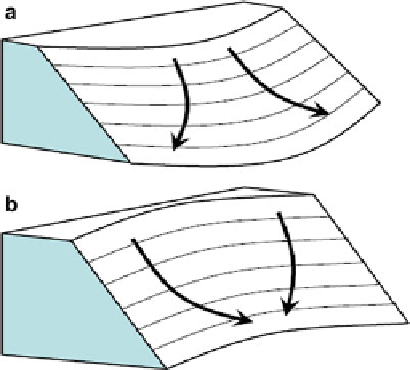Environmental Engineering Reference
In-Depth Information
Fig. 4.14 Divergent slopes
(a) disperse surface water,
whereas convergent slopes
(b) concentrate water.
Surface flow paths are
indicated by
arrows
Fig. 4.15 At the toe of a hill
slope the gradient is slightly
inclined or nearly level
3.
Slope shape
- Is the surface concave (e.g., depressions), where water would tend
to collect and possibly pond on the soil surface? On hillsides, are there conver-
gent slopes (Fig.
4.14
), where surface or groundwater may be directed toward a
central stream or swale? Or is the surface or slope shape convex (e.g., dome
shaped), causing water to run off or disperse?
4.
Landform
- Is the soil on a low terrace or floodplain that may be subject to
seasonal high water tables or flooding? Is it at the toe of a slope (Fig.
4.15
) where
runoff may tend to collect or groundwater emerges at or near the surface? Has
the microtopography been altered by cultivation?
5.
Soil materials
- Is there a restrictive layer in the soil that would slow or prevent
the infiltration of water? This could include consolidated bedrock, compacted
layers, cemented layers such as duripans and petrocalcic horizons, layers of silt
or substantial clay content, seasonal ice, or strongly contrasting soil textures
(e.g., silt over sand). Platy or prismatic soil structure may also result in restrictive
layers. Is there relatively loose soil material (sand, gravel, or rocks) or fractured
bedrock that would allow the water to flow laterally down slope?
6.
Vegetation
- Does the vegetation at the site indicate wetter conditions than at
other nearby sites, or is it similar to what is found at nearby upland sites?


